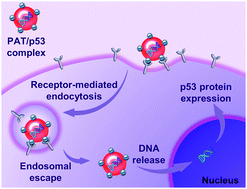Peptide-based vectors mediated by avidin–biotin interaction for tumor targeted gene delivery
Abstract
Smart vectors with good biocompatibility and tumor-targeting ability for gene therapy have attracted much research interest. Here, through a simple but universal alternative, a novel self-assembled gene delivery system with optimized targeting ability was developed. TAT-PKKKRKV peptide (P) was synthesized as the primary component of a gene carrier. Avidin (A) and biotin-transferrin (T) of different molar ratios (1 : 1 and 1 : 5) were subsequently introduced into P–DNA complexes to form PAT–DNA complexes (PAT1–DNA and PAT2–DNA) mediated by avidin–biotin interaction. Both PAT1–DNA and PAT2–DNA complexes exhibited efficient DNA-binding abilities and low cytotoxicity. In an in vitro transfection assay, PAT1–p53 complexes showed superior transfection capability in HeLa and HepG2 cells over COS-7 cells, primarily due to the over-expression of transferrin receptors on cancer cells. For PAT2–DNA complexes, the target transfection ability decreased with the excess content of T. This study provides a unique and all-purpose strategy to fabricate functionalized gene vectors, and the results indicate that the PAT1–p53 complex system has great potential for targeted cancer therapy.


 Please wait while we load your content...
Please wait while we load your content...